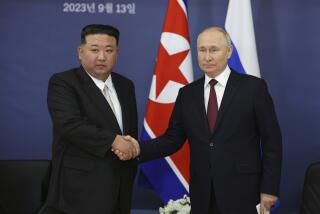Next Step : The ‘Iron-Silk’ Road May Provide New Trade for China : Trains linking eastern China to Western Europe are due to start running in mid-1992. Officials say the overland route will cut shipping time for Pacific Rim nations.
- Share via
URUMQI, China — The Chinese are already calling it “the New Eurasian Continental Bridge” or “the Iron-Silk Road.”
The grandiose titles apply to a new railway link that will enable travelers and trade to follow the footsteps of Marco Polo with greater ease than ever before.
Trains linking China’s eastern seaboard with Western Europe are due to start rolling on the 6,750-mile route in July, 1992. The journey to Rotterdam from China’s port of Lianyungang will stretch along the ancient Silk Road and will be 1,300 miles shorter than Pacific-Atlantic passage by the current Trans-Siberian route, which runs to the north.
This revitalized Silk Road is part of a strategic opening of China’s deep interior--a policy expected to profoundly affect the future of Central Asia. Key to the route is construction, now largely completed, of the new 290-mile Northern Xinjiang Railway linking Urumqi, capital of China’s far western Xinjiang region, with a railhead at the Soviet border.
Long one of the world’s most isolated places, Xinjiang expects to gain far easier access to international markets by looking west to the Soviet Union and through it to all Europe. Trade ties and private travel by highway across the Soviet border--which was closed from the late 1960s until 1983--have already begun to expand rapidly.
Rails of the new line, running north of the existing cross-border highway, reached the Soviet border at Alataw Pass in September. The event, which linked the Chinese and Soviet rail systems, was marked with much ceremony and celebration. But in this dry and desolate region, time-consuming work is still needed to build stations, immigration and customs offices and equipment for switching passenger coaches between the different gauge rails of China and the Soviet Union. Facilities are also to be constructed to handle reloading of freight at the border from Chinese to Soviet trains and vice versa.
Ge Guangwu, a spokesman for the Beijing Railway Co., the government corporation building the rail link, is among those with big dreams for what the new route could mean.
“After this railway link is finished, Pacific Rim nations such as Japan, South Korea, the Philippines, Singapore, Taiwan, Malaysia, Thailand and Australia can ship their goods first to Lianyungang (an ice-free harbor about 300 miles north of Shanghai) and then on to Europe,” Ge said in an interview. “It’s 8,000 nautical miles shorter than the sea route. . . . This land route is short and fast, with less risk of damage to goods. And transportation costs will be half as much. I think all these countries will be interested.”
The railway is expected to play a major role in expansion of Sino-Soviet trade. But many Chinese officials seem even more excited about improved access to the richer Western European market.
“Xinjiang is opening a door to the west,” Ge said enthusiastically. “Xinjiang products can be shipped to the Soviet Union, Eastern Europe, Western Europe, North Africa and the Middle East.”
Ge also stressed that “we welcome the American people to take this railway for tourism.”
Double-tracking and other improvements to existing lines across northern China are essential before the new transcontinental route can achieve its full potential, Ge admitted. But some of this work is already under way, he said.
Not all reports about the rail line exude as much optimism as Ge.
“Some Chinese transport officials argued that the new railway would not be able to realize its aims,” the official China Daily reported in a feature article about the line. “They pointed to the already strained railway transport system in China. ‘Most of China’s transport facilities--especially locomotives and railway cars--are old. The transportation system is also not managed satisfactorily,’ one of them said.”
Chinese officials say they expect transcontinental freight volume on the new line to ultimately exceed that on the Trans-Siberian route. It seems inevitable, however, that capacity limits on the new line will ensure that most goods shipped from East Asian nations to Western Europe will continue to go by sea for the foreseeable future.
Lianyungang can presently handle about 10 million tons of freight annually, but much of this must go to serve China’s needs. It is rapidly expanding its capacity by constructing new ship berths, the official China Daily reported.
China expects foreign income from transcontinental freight charges to be at least $50 million a year, the China Daily reported.
The new railway’s potential to increase Sino-Soviet trade got a boost from last year’s visit to Beijing by Soviet President Mikhail S. Gorbachev, which marked normalization of relations between the two nations after three decades of estrangement.
Xinjiang’s two-way trade with the Soviet Union totaled $120 million in 1989, up 19% over the previous year, according to Wu Zhangji, director of the region’s foreign trade and investment office.
Trade this year will be less, largely because of new restrictions imposed by Moscow on exports of Soviet goods, Wu said. The gradual transformation of Sino-Soviet trade from a barter basis to a hard-currency basis--a process expected to move forward significantly next year--also places restraints on growth because both countries face shortages of foreign exchange. But the long-term prospects are for expansion, according to Wu.
“Their (Soviet) heavy industry is relatively developed, and light industry has fallen behind,” Wu said. “So they face a relative lack of light industrial products in the market. As for Xinjiang, heavy industry is relatively backward, and light industry is more developed.
“From the point of view of mutual economic benefit, there are possibilities. From the point of view of geography, Xinjiang and the Soviet Union’s five Central Asian republics are quite near. And as for national customs (of Turkic minorities on both sides of the border), we have certain common points. In history, Xinjiang and the Soviet Union have had contacts. Especially with the opening of the new railroad through the Alataw Pass, conditions will exist for increased Xinjiang-Soviet trade. But this requires a process to solve the various problems that we now face.”
Saken S. Seidualiyev, general director of a foreign trade association run by Soviet Kazakhstan, said in a brief interview while visiting Kashi (Kashgar), a center of Uighur culture in southwestern Xinjiang, that he believes linguistic ties between Turkic groups on both sides of the Sino-Soviet border will contribute to development of trade.
Seidualiyev, an ethnic Kazakh, had just listened to a briefing in Uighur and found he could understand it without translation.
A wide variety of cooperative ventures are possible. The Benefit the Masses Leather Factory, located in Yining, 55 miles from the Soviet border, has a sheepskin processing agreement with a Soviet partner, for example. It calls for the Soviet side to provide 200,000 fresh sheepskins, trucked across the border at Horgas and on to Yining. The Chinese side must return 69 processed and dyed skins for every 100 received, retaining the rest as compensation. About 70,000 skins have been handled so far under the contract.
Horgas is also an important border crossing for travelers, mostly from Uighur, Kazakh, Tatar or other Turkic minority groups, who now can visit relatives in the Soviet Union. The rupture of Sino-Soviet relations in the 1960s left many families divided, and visits have resumed on a large scale only in the past few years.
“We don’t care about politics,” commented a Tatar man in Yining. “It’s just good to have trade and other contact again. War is bad. The officials, they don’t suffer. It’s the common people who suffer. I’ve been there (to the Soviet Union), my mother too. And our relatives from over there have come here.”
All of these developments have contributed to a surge of optimism among officials responsible for Xinjiang’s economic development.
Ju Junjiang, director of the Foreign Trade Bureau of the Ili Kazakh Autonomous Prefecture, headquartered in Yining, spoke enthusiastically of how the railroad would create conditions to develop a special investment zone in Kuitun, a town on the new line located halfway between Urumqi and the Soviet border.
“There’s no foreign investment yet, but preparations have been made,” Ju said. “The land is available, and water and electricity have been provided. . . . We want to invite foreign and domestic companies to come and invest, and export to the Soviet Union and farther west. If American investors want to come, we welcome them.”
More to Read
Sign up for Essential California
The most important California stories and recommendations in your inbox every morning.
You may occasionally receive promotional content from the Los Angeles Times.













